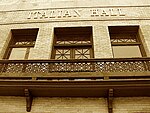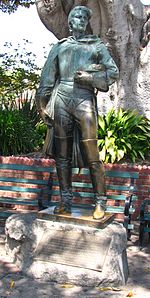Statue of Junípero Serra (Los Angeles)
1932 establishments in California1932 sculpturesBronze sculptures in CaliforniaCalifornia sculpture stubsMonuments and memorials in California ... and 7 more
Monuments and memorials removed during the George Floyd protestsOutdoor sculptures in Greater Los AngelesSculptures of men in CaliforniaStatues in CaliforniaStatues of Junípero SerraStatues removed in 2020Vandalized works of art in California

A statue of Junípero Serra (sometimes called Father Junipero Serra or Fra Junipero Serra) was installed in a portion of El Pueblo de Los Ángeles Historical Monument informally known as Father Serra Park in Los Angeles, California.
Excerpt from the Wikipedia article Statue of Junípero Serra (Los Angeles) (License: CC BY-SA 3.0, Authors, Images).Statue of Junípero Serra (Los Angeles)
North Los Angeles Street, Los Angeles Downtown
Geographical coordinates (GPS) Address Nearby Places Show on map
Geographical coordinates (GPS)
| Latitude | Longitude |
|---|---|
| N 34.0562 ° | E -118.2383 ° |
Address
Wall of Honor
North Los Angeles Street
90012 Los Angeles, Downtown
California, United States
Open on Google Maps











